Fabrication of versatile and sustainable cellulose nanocrystals from lettuce stalks as potential tamoxifen delivery vehicles for breast cancer treatment: biophysical, cellular and theoretical studies
Abstract
In recent years, cellulose nanocrystals (CNCs) have attracted increasing interest in drug delivery due to their low cost, biodegradability, and biocompatibility. This study reports the synthesis and characterization of cellulose nanocrystals (CNCs) loaded with tamoxifen (CNCs/TMX) for evaluating their binding mechanism to serum proteins. By using novel TMX-containing nano-formulations instead of chemotherapy, the toxic effects will be greatly decreased. CNCs are able to deliver small amounts of TMX to tumors over a long period of time and limit dose-dependent toxicity. According to XRD and Fourier-transform infrared spectroscopy, the non-cellulosic components were eliminated in the course of acid hydrolysis to liberate the crystal regions, while the outcomes of FESEM and TEM analyses confirmed the spherical shape of CNCs and CNCs/TMX. As the zeta potentials in both cases displayed a reasonable negative surface charge, their fluorescence measurements revealed a static quenching mechanism caused by the formation of HSA-CNCs/TMX, HTF-CNCs/TMX, and (HSA-HTF) CNCs/TMX complexes. The observed changes in the synchronous fluorescence results were related to the micro-environmental properties of Tyr and Trp residues. The data of circular dichroism confirmed the conversion of HSA and the HTF secondary structure during the interaction as binary and ternary systems. Moreover, using the FRET theory the distances between the donor and acceptor were calculated to be 2.31, 2.77 and 2.72 nm for HSA-CNCs/TMX, HTF-CNCs/TMX and (HSA-HTF) CNCs/TMX, respectively. Docking and MD simulations were used to study the conformational changes of two carrier proteins, HSA and HTF, in the presence of the CNCs/TMX complex. These in silico studies confirmed the results of in vitro studies. We also examined the anti-cancer effects of TMX and CNCs-TMX on MCF-7 and MDA-MB-231 breast cancer cells and human foreskin fibroblasts. The expressions of proapoptotic caspase-3 and metastasis-related MMP-9 at the mRNA and protein levels were analyzed through the qPCR technique. Our outcomes pointed out the superior impact of CNCs-TMX with a lower dosage of TMX on breast cancer therapy when compared to TMX and signified the potential applicability of CNCs as a nano-carrier of TMX.



 Please wait while we load your content...
Please wait while we load your content...